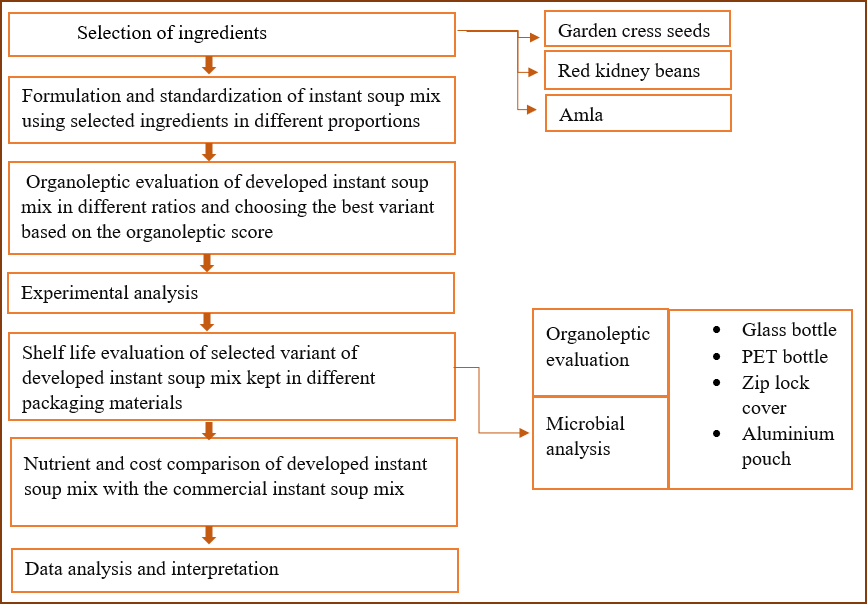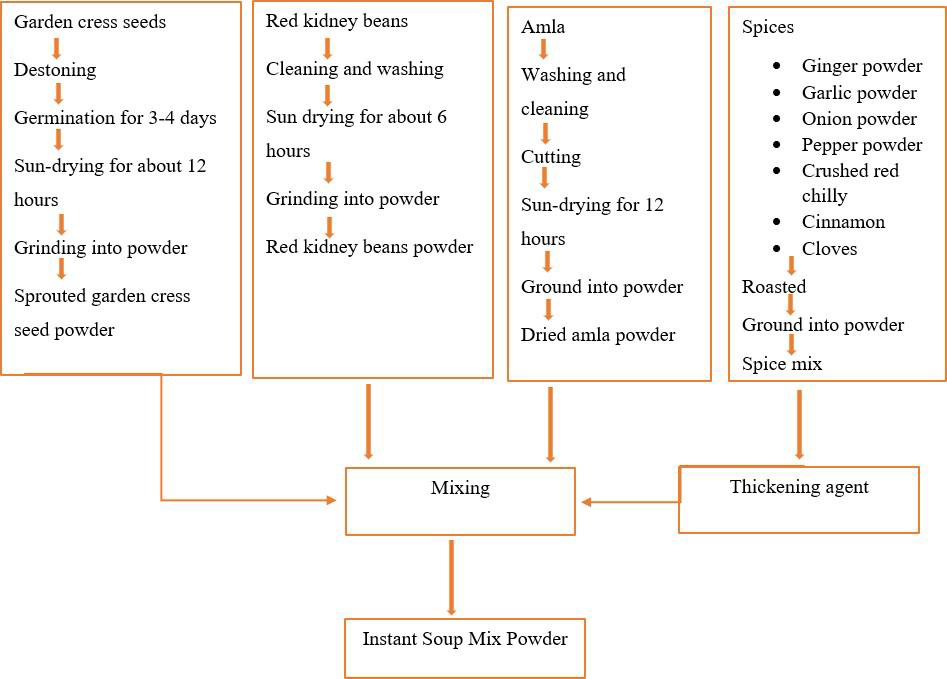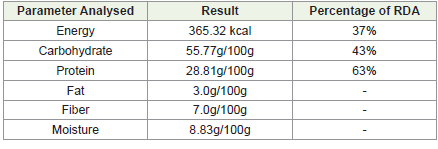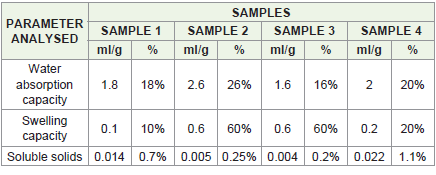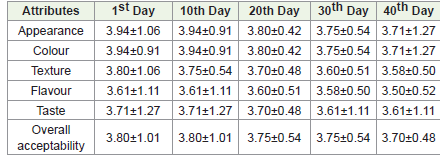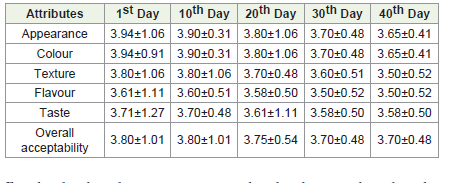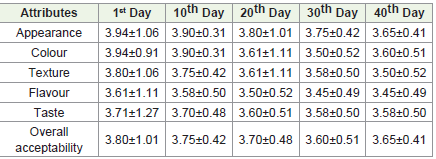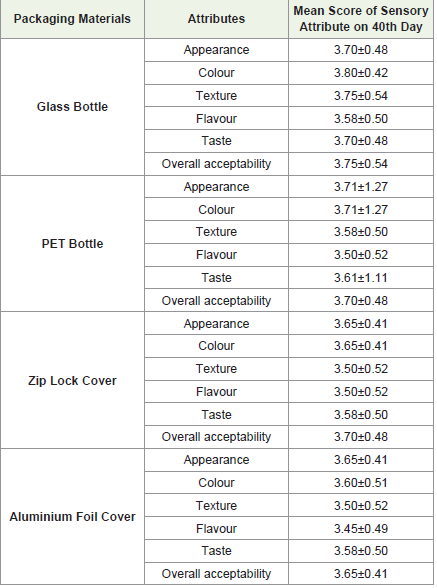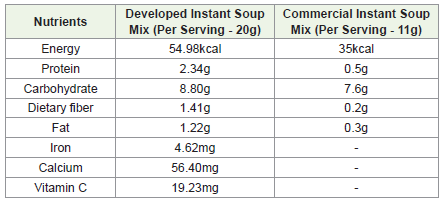Research Article
Development of Nutritious Instant Soup Mix, Its Organoleptic and Experimental Evaluation with its Popularization
Aiswarya S Kumar * and Kavitha Vijayan
Dietetics and Food Service Management, Department of Family and Community Science, CMS College Kottayam (Autonomous) 686001, Mahatma Gandhi University, Kottayam, Kerala, India
*Corresponding author: Aiswarya S Kumar, Dietetics and Food Service Management, Department of Family and Community Science, CMS College Kottayam (Autonomous) 686001, Mahatma Gandhi University, Kottayam, Kerala, India
Article Information:Submission: 14/11/2023; Accepted: 23/01/2023; Published: 30/01/2024
Copyright: ©2024 Kumar AS, et al. This is an open-access article distributed under the Creative Commons Attribution License, which permits unrestricted use, distribution, and reproduction in any medium, provided the original work is properly cited.
Abstract
The present study is focused on developing a nutrient-rich instant soup mix and to conduct the experimental and shelf life evaluation. Four alternative formulations were created with various component ratios. The formulation with a larger ratio of sprouted garden cress seed powder, along with equal amounts
of red kidney beans and amla powder was selected as the best variant. The proximate study of the selected sample contained the energy, protein, fat, carbohydrate, moisture, and fiber content as 65.32kcal,28.81g/100g,3.0g/100g, 55.77g/100g,8.83g/100g and 7.0g/100g respectively. In the nutrient analysis, iron and calcium are 4.8mg/100g and 20mg/100g respectively. The total antioxidant activity is 567mg/kg respectively. The physicochemical properties such as water absorption capacity, swelling capacity, and soluble solids were 18%,10%, and 0.7% respectively. The total ash and acid insoluble ash were 3.59g/100g and 0.09g/100g. It can be concluded that the developed instant soup mix kept in glass bottle was selected as the best packaging material with a good shelf life of more than 60 days at room temperature. So, the developed instant soup mix will help to increase the nutritional status of an individual.
Keywords:Instant soup mix; Garden cress seeds; Red kidney beans; Formulation; Shelf life
Introduction
The increase in population and urbanization has made less time
available for people to prepare healthy foods. As a result, most of them
consume whatever is available or food that requires less preparation
time, without considering the health benefits of the food. Instant
soups play an important role in balancing the nutrients required for
people to stay healthy, and they can be prepared easily with less time
[1].
Soup is a filling, flavourful, and substantial meal. It can be made
by combining items like meat or vegetables with stock, milk, or water.
A soup is a savoury and nourishing liquid food that is typically served
at the start of a meal or snack [2].
Instant soups are usually considered universal comfort food. An
instant soup is a type of soup made for quick and easy preparation.
Instant soup is frequently pre-portioned and pre-cooked. This type of
soup is marketable as a wholly dry product. The soup is heated briefly
before consumption after being reconstituted with water or another
liquid by the drinker[3].
The majority of instant soups have a strong flavour and low salt
content. Instant soup mixes are popular because of their portability
and long shelf life. They are free from pathogenic attacks and their
quality may be maintained for a month at a normal room temperature.
They don’t have any microbial contamination and are hygienic. They
also have convenient and ingenious packaging.
Lepidium sativum, often known as garden cress seeds or
“Chandrasur” in the local language, is a member of the Brassicaceae
family (Cruciferae). [4]Garden cress seeds differ from many spices in
that it has significant quantities of iron and folic acid. Garden cress
seeds have a wide range of medicinal properties such as antioxidant
properties, anti-anaemic properties, anti- diabetic properties, and
anti-inflammatory properties and they also have many health benefits
[5].
Red kidney beans, which is also referred to as common kidney
bean and rajma in India. These beans have a mild flavour and a reddishbrown
colour. Although kidney beans mostly include carbohydrates
and fibre, they are also an excellent source of protein. They include
significant amounts of folic acid, calcium, carbohydrates, fibre, and
proteins, among other vital elements, all of which are crucial for the
body’s healthy functioning[6].
Phyllanthus emblica often referred to as emblic, Indian gooseberry,
or amla is a member of the Phyllanthaceae family of deciduous trees.
The fruit amla is regarded as the best anti-aging fruit. Amla berries
include several healthy antioxidants and vitamins [7].
Based on the above-mentioned facts, the present study was done
on the formulation and development of a nutritious and healthy
instant soup mix using sprouted garden cress seeds, red kidney beans
and amla to find out the best among them based on organoleptic
evaluation from different formulations. The analysis of nutritional
components was done by various experimental analysis and the
assessment of shelf life was by microbial analysis and organoleptic
evaluation. [Figure 1].
Materials and Methods
Selection of Ingredients:
Ingredients required for the development of instant soup mix
were selected based on their nutritional and functional properties.
The major ingredients were garden cress seeds, red kidney beans, and
amla. A spice blend containing diverse spices such as ginger powder,
onion powder, pepper powder, garlic powder, cinnamon, cloves, and
crushed red chilli was also chosen to enhance the flavour, colour,
texture, and appearance of the developed instant soup mix.The selected ingredients were procured from the local market.
Good quality garden cress seeds and red kidney beans were selected.
The best quality organic amla was selected that feels hard, well
skinned, and looked bright yellowish-green in colour.
Formulation and Standardization of Instant Soup Mix using Selected Ingredients in Different Proportions:
The formulation and standardization of the developed instant soup mix were done with four alternative formulations. The different ratios of the main ingredients were formulated. The ratio of spice mix
and thickening agent remained the same for all samples.Selecting the Best Thickening Agent:
Three different types of thickening agents, including ragi flour,
wheat flour, and corn starch, were investigated for the development
of the instant soup mix. The nutritional qualities of the thickening
agent , as well as its boiling time, thickening time, and thickening
temperature, were taken into consideration while selecting it.Preparation of Developed Instant Soup Mix using the Selected Ingredients:
After the selection of ingredients, the preparation of the instant
soup mix was started. Garden cress seeds were chosen and sprouted
before being dried into a powder. The red kidney beans and amla
powders were dried and ground finely. The spice mixes were dried
separately, roasted, and ground into fine powders [Figure 2].Organoleptic Evaluation:
Sensory evaluation was done by comparing the control sample
of the instant soup mix and the other four developed formulations.
The sensory assessment has been performed using the developed
scorecard to evaluate the sensory attributes of soup based on a 5-point
hedonic scale.Experimental Analysis:
Experimental analysis such as proximate composition, nutrient
analysis, antioxidant assay, and physiochemical properties were
determined for the developed instant soup mix. The proximate
composition of the developed instant soup mix was done for the
determination of energy, moisture, fat, carbohydrate, and protein.
The nutrient analysis was done for the estimation of iron and calcium
properties.Additionally, the physiochemical properties of the developed
instant soup mix were also analyzed. The physiochemical properties
such as water absorption capacity, swelling capacity, and soluble
solids were determined.
Shelf-life Evaluation of Developed Instant Soup Mix Using Different Packaging Materials:
The shelf life evaluation among the four variants of the developed
instant soup mix was done in four different packaging materials such
as glass jars, PET bottles, zip lock covers, and aluminum foil covers.
All the freshly prepared samples were placed hygienically in the abovementioned
packaging materials for 40 days at room temperature. For
every tenth day, samples from all packaging materials of respective
dates have been out, and conducted the sensory evaluation in an
informal way. Change in colour, texture, and aroma has been checked
and the presence of any microbial growth was also observed. The
above-mentioned pattern of evaluation has been repeated till the 40th
day.A) Shelf-Life Assessment by Organoleptic Evaluation:
Shelf-life assessment by organoleptic evaluation was done for the
selected variant on day 10, day 20, day 30, and day 40. Attributes such
as appearance, colour, texture, flavour, taste, and overall acceptability
were assessed.
The statistical significance of sensory attributes of the developed
instant soup mix kept in different packaging materials such as glass
bottles, PET bottles, zip lock covers, and aluminium foil covers was
statistically analysed using the two-way Anova test.B) Shelf-life Assessment by Microbial Analysis:
The shelf-life assessment by microbial analysis of the developed
instant soup mix was done. The total plate count, yeast and mold
analysis of the product were analysed.Nutrient and Cost Comparison of the Developed Instant Soup Mix with the Commercial Instant Soup Mix:
A comparison of the nutritional values of the developed instant
soup mix with the commercial instant soup mix was done. Similarly,
the cost of the developed instant soup was also assessed along with the
overhead charges that were compared with the cost of commercially
available instant soup mix.Data Analysis and Interpretation:
The data was analysed to determine its acceptability and is
interpreted under results and discussions.Results & Discussion
Selecting the Best Thickening Agent:
For the developed instant soup mix, three different types of
thickening agents were examined. The different types of thickening
agents such as corn flour, wheat flour, and ragi flour have been used.
The boiling time and thickening time of corn flour, wheat flour, and
ragi flour almost remained the same with only a slight difference in
seconds. The cooking temperature of wheat flour and ragi flour is the
same.In sensory attributes, the appearance, colour, texture, flavour, and
taste of ragi flour and corn flour are seen as more acceptable than
wheat flour. When comparing the nutritional benefits of ragi flour
and wheat flour, ragi flour is seen as more nutritional. Based on all
the properties ragi flour is selected as the best thickening agent for the
developed instant soup mix.
Formulation and Standardization of Instant Soup Mix Using Selected Ingredients in Different Proportions:
For the developed instant soup mix, four different formulations
were made with various component ratios. The recipe was standardized
for 20 grams of instant soup mix powder in 200ml of water. Four
alternative formulations were created with various component ratios.
A larger ratio of garden cress seed powder was used in sample 1, along
with equal amounts of red kidney beans and amla powder as 22:9:9. A
larger ratio of red kidney beans powder was used in sample 2, alongwith an equal amount of garden cress seed and amla powder as 9:22:9
A larger ratio of amla powder was used in sample 3 together with an
equal amount of garden cress seed powder and red kidney powder as
9:9:22. Garden cress seed, red kidney beans, and amla powder were
combined in equal amounts for sample 4 as 14:14:14. The ratio of
spice mix and the thickening agent was equal for all four samples. The
ratio of thickening agent with spice mix is 37:20.
Organoleptic Evaluation Score of Developed Instant Soup Mix:
A) Organoleptic Evaluation Score for Appearance of Developed Instant Soup MixThe mean score of appearance for sample 1 is 3.94, sample 2 is
3.71, sample 3 is 4.00, and sample 4 is 3.90. When comparing the
mean score value of the appearance between the samples, the highest
mean score of 4.00 is for sample 3, which may be due to the higher
ratio of amla powder which gives a youthful and smooth appearance.
B) Organoleptic Evaluation Score for Colour of Developed Instant Soup Mix:
The mean score of colour for sample 1 is 3.94, sample 2 is 3.8,
sample 3 is 4.0 and sample 4 is 3.78. When comparing the mean score
value of the colour between the samples, the highest mean score of 4.0
is for sample 3, which gives a light brown colour and it may be due to
the highest ratio of amla powder.C) Organoleptic Evaluation Score for Texture of Developed Instant Soup Mix:
The mean score of texture for sample 1 is 3.8, sample 2 is 3.71,
sample 3 is 3.77 and sample 4 is 3.88. When comparing the mean
score value of the texture between the samples, the highest mean
score of 3.88 is for sample 4, which is smooth and lump-free and it
may be due to the equal ratios of sprouted garden cress seed powder,
red kidney beans powder and amla powder.D) Organoleptic Evaluation Score for Flavour of Developed Instant Soup Mix:
The mean score of flavour for sample 1 is 3.61, sample 2 is 3.66,
sample 3 is 3.78 and sample 4 is 3.58. When comparing the mean
score value of the flavour between the samples, the highest mean
score of 3.78 is for sample 3, which has a unique sour flavour and it
may be due to the highest ratio of amla powder.E) Organoleptic Evaluation Score for Taste of Developed Instant Soup Mix:
The mean score of taste for sample 1 is 3.71, sample 2 is 3.57,
sample 3 is 3.72, and sample 4 is 3.52. When comparing the mean
score value of the taste between the samples, the highest mean score
of 3.72 is for Sample 3, which has a unique sour flavour and it may be
due to the highest ratio of amla powder.F) Organoleptic Evaluation Score for Overall Acceptability of Developed Instant Soup Mix:
The mean score of overall acceptability for sample 1 is 3.80, sample
2 is 3.66, sample 3 is 3.78 and sample 4 is 3.76. When comparing the
mean score value of the overall acceptability between the samples, the
highest mean score of 3.80 is for sample 1, which gives good overall
acceptability and it may be due to the higher ratio of sprouted garden
cress seed powder.Experimental Analysis:
Experimental analysis has been conducted for the selected variant
of the developed instant soup mix including proximate composition
analysis, nutrient analysis, antioxidant assay, and determination of
physiochemical properties.A) Proximate Composition Analysis of the Developed Instant Soup Mix:
The proximate composition analysis of the developed instant
soup mix contained an energy of 365.32 kcal, a protein content of
28.81g/100g, a fat content of 3.0g/100g, the carbohydrate content of
55.77g/100g, a fiber content of 7.0g/100g and moisture content of
8.83g/100g.According to Bogati (2020) in their study on the formulation of
gundruk soup and its evaluation revealed that it contains a moisture
content of 9.5%, crude fat of 5.37%, protein of 12.2%, crude fiber of
6.53%, total ash of 19.0%, and carbohydrate of 52.74%.
B) Nutrient Analysis of the Developed Instant Soup Mix:
The nutrient analysis of the developed instant soup mix shows
an iron content of 4.8mg/100g and a calcium content of 20mg/100g.According to Abeysinghe (2006) in the formulation of an MSGfree instant vegetable soup mix revealed that it contains 4.6 % iron and 0.17 % calcium.
C) Antioxidant Activity of the Developed Instant Soup Mix:
The antioxidant analysis of the developed instant soup mix shows
an antioxidant activity of 567mg/100g.According to Farzana (2016) in their study on the formulation
and nutritional evaluation of a healthy vegetable soup powder
supplemented with soy flour, mushroom, and moringa leaf revealed
that it contains vitamin C of 6.4mg.
D) Determination of Physiochemical Properties of the Developed Instant Soup Mix:
The physiochemical properties of the different samples of
developed instant soup mix show that the water absorption capacity
of sample 1 is 1.8ml/g, sample 2 is 2.6ml/g, sample 3 is 1.6ml/g and
sample 4 is 2ml/g. The swelling capacity of sample 1 is 0.1ml/g,
sample 2 and sample 3 have a swelling capacity of 0.6ml/g and sample
4 has 0.2ml/g. The amount of soluble solids present in sample 1 is
0.014ml/g, sample 2 is 0.005mg/l, sample 3 is 0.004mg/l and sample
4 is 0.022mg/l.Shelf-life Evaluation of the Developed Instant Soup Mix in Different Packaging Materials:
Shelf-life evaluation has been conducted for the developed
instant soup mix, to explain how long a food will maintain its
quality while being stored. Shelf life evaluation was conducted using
different packaging materials such as glass bottle, PET bottle, zip lockcovers and aluminium foil covers till the 40th day. The organoleptic
evaluation and microbial analysis have been conducted during this
shelf life period.
A) Shelf life Assessment by the Organoleptic Evaluation During the Storage Period.:
The organoleptic evaluation was done for the selected variant of
the developed instant soup mix on day 10, day 20, day 30 and day 40
which was stored in four different packaging materials such as glass
bottles, PET bottle, zip lock covers and aluminium foil covers.The developed instant soup mix kept in glass bottles had shown
less change in all the attributes from the 1st day to the 40th day. The
developed instant soup mix kept in glass bottles almost remained the
same without any significant changes. The developed instant soup
mix remains safe and organoleptically acceptable in glass bottles.
The developed instant soup mix kept in PET bottle has less change
in all the attributes from the 1st day to the 40th day. The mean score
of overall acceptability was seen from 3.80 to 3.70, which was seen as
acceptable.
The mean score of overall acceptability was seen as acceptable and
less change was seen in overall acceptability from 3.80 to 3.70. The
developed instant soup mix kept in zip lock covers was overall seen as
acceptable but some slight changes were seen in the other attributes.
The mean score of overall acceptability was seen as less acceptable
and change occurred from 3.80 to 3.65. The developed instant soup
mix kept in aluminium foil covers was seen as less acceptable and
some slight changes had occurred in all its attributes.
Determination of Best Packaging Material Appropriate for Developed Instant Soup Mix by Organoleptic Evaluation:
The developed instant soup mix kept in different packaging
materials has been organoleptically evaluated till the 40th day. Based
on the organoleptic score best packaging material has been selected.For the developed instant soup mix glass bottle was selected as the
best packaging material because the product remains safe and more
palatable without any microbial spoilage. Glass has a very low rate
of chemical reactions, ensuring that the contents of a glass bottle
maintain their strength, aroma, and flavour.
Shelf life Assessment by Microbial Analysis:
The shelf life assessment by microbial analysis has been conducted
during the shelf life period of the developed instant soup mix. The
standard plate count was seen as 13,80,000 cfu/g and yeast and mould
count was 61000 cfu/g.Nutrient Comparison of Developed Instant Soup Mix with Commercial Instant Soup Mix:
The nutrients present in the developed instant soup mix which
were obtained by lab analysis were compared with the commercially
available instant soup mix. The developed instant soup mix contains
a higher amount of energy, protein, carbohydrate, and dietary fiber
content in them. The amount of fat was seen as similar in both the
products with only a 0.3g difference, indicating that both instant soup
mixes had less fat. In the terms of minerals, the developed instant
soup mix had iron and calcium of 0.96mg and 4mg, which were not
present in the commercial instant soup mix. The developed soup mix
contains vitamin C of 11.34 mg which was absent in the commercial
instant soup mix.
Table 11:Sensory Attribute Mean Score of the Developed Instant Soup Mix Kept
in A luminium Foil Covers
Table 12:Determination of Best Packaging Material Appropriate for Developed
Instant Soup M ix by Organoleptic Evaluation
All these findings led to the conclusion that the developed instant
soup mix was perceived as being more nutrient-dense than the
commercial instant soup mix.
Cost Comparison of Developed Instant Soup Mix with Commercial Instant Soup Mix:
The cost of the developed instant soup mix was calculated and
it was compared with the commercially available instant soup mix.
The developed instant soup mix has a price of 6.5 Rs which was less
than the 10 Rs cost of commercial instant soup. The developed instant
soup mix was deemed more profitable because it is inexpensive and
rich in nutrients.Conclusion
On the basis of the findings, it can be concluded that the
developed instant soup mix is more nutritional and healthier than
the commercially available soup mixes. The developed instant mix
contains a high amount of energy, protein, carbohydrate, iron,
calcium, and vitamin C than that of commercial ones, and also they
are free from additives and preservatives. The cost of the developed
instant soup mix is profitable and inexpensive as compared to
commercial ones. In the developed instant soup mix, the nutrient
content is retained to its maximum by minimal processing and it will
help to increase the nutritional status of an individual.
Acknowledgement
First of all I owe my sincere gratitude towards God Almighty for
bestowing his grace, wisdom, knowledge and courage on me for the
successful completion of the study.
I extend one earnest and wholehearted gratitude to Dr. Varghese
C. Joshua, Principal, CMS College, Kottayam (Autonomous) for the
valuable cooperation extended during this study.
I am deeply indebted to Mrs. Kavitha Vijayan, Head of the
Department of Dietetics and Food Service Management, for her
valuable help, necessary directions and encouragement during the
period of study.
I would like to express my heartfelt gratitude to Mrs. Kavitha
Vijayan, the guide of the study, for giving me insight into all the
aspects of my study, constant encouragement, expert guidance,
valuable corrections and constant support since the planning till the
completion of the project.
I am also thankful to all other faculty members of the department
for their cooperation and constant support throughout the study. I
am also thankful to Mr. Shinu Peter, Assistant Professor, Department
of Chemistry, CMS College, Kottayam for his kind cooperation and
constant support throughout the study.
I am also thankful to Mrs. Maneesha George, Assistant Professor,
Department of Statistics, CMS College, Kottayam for her kind
cooperation and constant support throughout the study.
Grateful acknowledgment is also offered to all the staff of Accurate
Analytic Lab, Thoppumpady, Cochin for their kind cooperation.
I am conveying my heartfelt thanks to my classmates for their
kind cooperation and help during the course of the study.
Words are not enough to thank my beloved parents and my
family, for the unfailing support, constant help and cooperation in
the completion of the project.
I express my sincere thanks to all those who helped me in the
successful completion of the research work.

